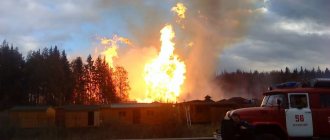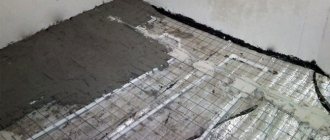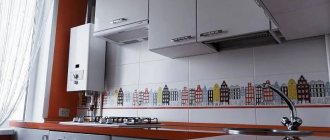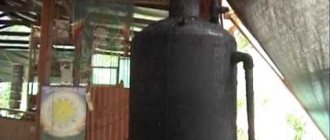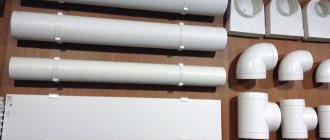At the construction stage, the gas system inside the house is designed as a single unit for all apartments. New apartment buildings often have a common system, in which all residents are individually connected to it apartment by apartment. Internal renovation work also often requires changes to the original design. At the same time, the installation of gas pipes in an apartment or private house is classified as high-risk work. In order to prevent an emergency either at the stage of work execution or during operation, it is necessary to fulfill all regulatory requirements from creating a project to checking the quality of the connection of system elements.
Gas installation work in the apartment
Features of installation work with gas pipes in an apartment building
The beginning of work will be related to the answer to the question: what equipment will the system service. After this, only specialists have the right to carry out design work taking into account the wishes of the customer and the actual conditions of the apartment layout.
Important! Making changes to the existing gas supply system of an apartment building is spontaneously prohibited at the legislative level.
The customer must provide, in addition to technical documents, the following information:
- what will be connected to the gas pipeline: gas stove, water heater, individual heating system, water heating devices. The quantity is indicated and technical passports are provided;
- hypothetical options for the location of all connected devices;
- information about changes made to the gas pipeline in neighbors’ apartments, the depth of the pipeline;
- wishes about the level of installation and accessibility of all components (protection of access for children, animals).
When planning to install gas pipes in a private apartment, you need to remember that:
- gas pipes are not installed in living rooms;
- It is impossible to decorate the pipeline with any structure that cannot be quickly dismantled. It should always be freely accessible;
- The ventilation system should not be common to the entire apartment. In a room with gas pipes, an autonomous one is provided;
- Where devices are located, it is necessary to provide fire protection measures, for example, covering the wall with non-flammable plaster.
Checking the quality of work
Underground gas pipeline entry into a low-rise building
Gas pipeline entries into low-rise residential buildings
should be included in non-residential premises accessible for inspection of gas pipelines (for example,
kitchens, corridors
).
Arrangement of low pressure gas pipeline inputs
into technical undergrounds and technical corridors and wiring through these premises in residential and public buildings is ALLOWED only when external gas pipelines are connected to these buildings in intra-block collectors (in accordance with the requirements for the design of intra-block utilities in collectors and technical corridors).
Inputs of gas pipelines into public buildings, buildings of public catering establishments and public utility facilities are provided (in special closed channels) in the staircase or directly into the premises where gas appliances are installed.
Gas pipeline entries
must not pass through
foundations or under
building foundations.
Minimum distances
horizontally and vertically between gas pipelines and buildings, industrial wiring, structures are accepted by design organizations in accordance with current regulatory documents.
It is ALLOWED to reduce these distances in cramped conditions. The decision on this is made by the design organization, indicating additional measures for the quality of the pipes used, control of welded joints, etc.
Depth of gas pipelines
at least
0.8 m
to the top of the gas pipeline or casing is accepted; a reduction to
0.6 m
in places where there is no traffic passage.
Installation of base gas pipeline inlets
ALLOWED in buildings for all purposes.
An option for installing an open basement gas pipeline entry
into a low-rise building
is shown in Fig. 5.
Laying liquefied gas pipelines
NOT ALLOWED in technical corridors, technical undergrounds and basements.
Gas pipelines
in technical corridors, technical undergrounds and basements are performed by welding; installation of shut-off valves is NOT ALLOWED.
When laying communications in collector channels, a gas-tight diaphragm
, and the wall of the house at the entry point is sealed.
Gas pipelines in residential buildings
should be laid openly.
Laying risers
NOT ALLOWED in residential premises, bathrooms and sanitary facilities.
In buildings on risers and gas distribution pipelines
installation of plugs is NOT ALLOWED.
On base inputs
gas pipeline
plugs
can only be installed outside the building.
The plugs must have a diameter of no more than 25 mm
.
Yard (intra-village) gas pipelines
ensure the distribution of gas to houses located within the same yard, on the territory of the block.
Yard gas pipelines
are laid in the ground and in pass-through collectors-channels along with other communications or along the walls of houses.
When laying a gas pipeline with other communications
(water supply, heating network, etc.) - the distance between individual pipelines is taken to be at least
0.3 m
.
READ ALSO: Connecting and installing a gas stove to a cylinder
For laying gas pipelines together with power and lighting cables
- there must be permission from Gosgortekhnadzor.
Just like a permit to build a house, this is a necessary process
Just like building a house, a permit is required.
SNIP, project formation, final documentation
For apartment buildings there are strict standards for installing gas equipment:
- gas pipeline systems should not intersect with door, window openings, ventilation lines and shafts;
- pipes are laid at a height of no lower than 2 m from the field level;
- ceiling height in rooms with gas equipment is more than 2.2 m;
- the length of flexible pipeline sections is limited;
- the distance between gas and electrical equipment of any type is regulated by the rules for installing electrical equipment;
- access not only to individual components, but to the entire system must be free for repair and maintenance work;
- between the room with gas-powered appliances and other rooms there must be a barrier in the form of a door or any partition;
- the room has a window with a ventilator or ventilation mode, operating supply and exhaust ventilation;
- the type of pipe fastening (hook, bracket, clamp, hanger) and the distance between the fastening points is determined by SNIP.
Kitchen project diagram
Pay attention! If the system is installed under liquefied gas, a slope of 3 degrees is provided.
The design organization begins work if a package of documents is provided. It's forming
- from a notarized copy of the technical passport for the apartment;
- an expert opinion, documented in an act, on a chimney pipe made of gas;
- permission to connect from the architectural and planning organization; all technical documentation for gas appliances (certificates of conformity, technical data sheets).
But you can not collect documents yourself, but from the very beginning provide the opportunity for a special bureau to do this. Then the customer receives a finished project with all approvals, as well as estimates and costs. Additionally, it is necessary to draw up an agreement for technical supervision.
After receiving the project, installation work is carried out. The last stage of commissioning a new gas pipeline consists of the following steps:
- Compile a package of executive and technical documentation.
- Conduct an inspection of the correctness and quality of the work performed by a commission consisting of the customer, the contractor, and representatives of the city gas company.
- Seal the gas meter.
Gorgaz representatives have the right to constantly monitor the operation of gas equipment.
Sealing of the meter by a representative of Gorgaz
Which pipes to choose
The choice of pipes for gas pipelines in residential buildings of any type is limited by guests and gas tightness and resistance to mechanical damage are taken into account. These can be steel or copper pipes. In some cases, internal wiring between devices is permitted through the use of reinforced vulcanized rubber tubes or certified flexible hoses.
The gas pipeline inside the house belongs to a system with a pressure of up to 0.05 Pa, which is classified as low. Such systems are serviced by general-purpose pipes, classified as straight-seam electric welded pipes. When choosing a pipe, they are guided by the following parameters:
- external and nominal (internal) diameter. This value depends on the specifics of the project, and not on the type of pipe;
- selection of the optimal type of connection, which is considered welded. Both copper and steel pipes are suitable for this. In places where shut-off valves, gas and instrumentation devices are installed, flange, threaded connections, or couplings are allowed;
- copper pipes can be connected using press fittings;
- Copper products are more expensive, but have better anti-corrosion properties than steel ones. They have a more aesthetic appearance even when unpainted.
Important! Installing plastic pipes indoors is not only illegal, but also dangerous: the connection of the elements of the gas pipe system may become leaky when the building shrinks, and the action of ultraviolet radiation destroys the plastic.
Gas pipes
Pipe diameter
Recommended pipe parameters are presented in the table
| Common name | Designation | External diameter, mm | Internal diameter, mm |
| An inch and a quarter | 1 1/4 | 42,3 | 32 |
| Inch | 1 | 33,5 | 25 |
| Three-quarter | 3/4 | 26,8 | 20 |
| Half-inch | 1/2 | 21,3 | 15 |
These values are suitable for low pressure gas systems, and therefore for installation in a private house and apartment.
For a private house, the pipe diameter is calculated taking into account the following indicators:
- total amount of gas consumption;
- number of devices;
- type of heating system;
- total area of the building.
Gas pipe in the kitchen: norms, rules, requirements
All work on moving and replacing metal pipes, especially those requiring welding, is carried out by representatives of Gorgaz or another authorized organization.
Having received an application from residents, they are always interested in the reasons for the planned transformations. Most often, it is necessary to change the piping in the kitchen without changing the layout or moving equipment to other rooms.
The reasons may be different:
- replacing old equipment - purchasing a gas water heater, stove or boiler - which requires a little more space;
- major renovation in the kitchen;
- moving the gas stove from the window 0.5-2 m towards the sink;
- changing the installation location of the gas meter;
- moving a horizontal pipe from a great height under a table top, etc.
Often, the relocation of pipes is required in new buildings, where the original location of significant kitchen objects defies logic and explanation: suppose, if in a 15-meter kitchen the gas stove is located near the window, the sink is in the opposite corner, and the hood is on the other side, above the entrance to the kitchen.
We have to correct the design mistakes and move the stove closer to the sink so that food can be cooked in comfortable conditions.
It is strictly forbidden to carry out work to move the gas riser. The only change allowed is to disguise the pipes with easily dismantled structures, for example, wall-mounted kitchen cabinets
The most common reason is the purchase of a new kitchen set with built-in equipment (oven and hob). In this case, the pipes need to be either shortened or lengthened, depending on the planned installation location of the devices.
If you want to find out how best to move a gas pipe in an apartment with redevelopment, we recommend contacting a design organization to draw up a transfer plan.
The fact is that in typical city apartments it is prohibited to reinstall risers, pipes, as well as any gas equipment in living rooms, and even to combine a kitchen and a room, permission is also required.
Hello, dear readers. If there is a gas pipe in the kitchen, special standards apply to it. This includes distances from surfaces and from household appliances. Proper installation of gas pipes throughout the apartment is also important.
The gas pipeline is installed in the apartment according to a previously developed plan. But even before this, it is necessary to determine the operating conditions of the gas pipeline. So, if gas units operate in the kitchen, it will become a mandatory element for them. Its presence in the boiler room is the key to warmth throughout the house.
For the positions of the gas pipe in the kitchen and apartment, the standards are as follows:
- No installation in residential areas or ventilation shafts.
- Intersection with openings for windows and doors is unacceptable.
- Laying in hard-to-reach areas is prohibited. For example, behind designer decoration on the wall. Gas equipment must be provided with quick and easy access in case of malfunctions.
- The minimum distance of the gas pipe from the floor is 2 m.
- When using thin-walled pipes, the length of flexible communication components should not exceed 3 m. The density of connections of network elements is also of great importance.
- Installation is permitted only in those rooms where the minimum ceiling height is 220 cm. And these rooms must be well ventilated.
- The kitchen should not be provided with ventilation affecting the living areas.
- Wall and ceiling surfaces close to gas appliances must have a special coating of non-combustible plaster. If there is no such coating on the wall, it must be insulated from gas appliances using a metal sheet. Its suitable density is 3 mm.
To lay a gas pipe in the kitchen of a private house, you also need to know the standards. To begin with, gasification here begins with notification of the local gas organization and the planned work. It provides a technological condition that determines the algorithm for constructing a gas pipeline. The technical issue is being resolved. A personal development for gasification of a certain area is created. Also, a warrant for the installation of a gas pipeline is issued by the traffic police.
If neighboring houses are already provided with gas, you only need to connect the pipes in a specific area to the main network. The working pressure factor is also important here. Its parameter in the main pipes determines the choice of pipes to pass into the house.
The preferred gas source determines the gas supply technology: centralized or autonomous.
Gas pipelines can also run to private homes underground or above it.
And the standards for installing pipes to the kitchen in a private house are identical to the points in the housing issue.
Installation standards
The rules and regulations for installing a gas pipe in the kitchen are as follows:
- Before work, close the main valve.
- The gas pipeline is purged if the pipe is moved.
- The pipe is secured to the wall. These are special clamps and brackets.
The type of fastener is determined by the length and diameter of the pipes.
- If there are electrical cables near the pipes, then the minimum distance here should be 25 cm. And gas equipment is 50 cm away from the electrical panel.
- Location near cooling equipment is unacceptable. In this matter, owners often make mistakes. Is it possible to place a refrigerator near a gas pipe? It is forbidden. So the refrigerator radiator can quickly overheat, and the device itself will become faulty.
- The minimum distance from the gas pipe to the stove is formed as follows: the branch to it goes only along the line of the connecting fitting. The shut-off valve is placed 150 cm from the floor and 20 cm from the side of the stove. The slab is installed using a heat-resistant flexible hose.
- Work should be carried out in a room with stable ventilation and natural light.
- The minimum ceiling height is 220 cm.
- The slab and the opposite wall must be separated by at least 100 cm.
- The surfaces around the pipes and slabs are covered with fire-resistant material - plaster.
- The pipes are routed so that the slab is 7-8 cm from the walls.
- The stove is used only in a kitchen that has a fence from the corridor: a wall or partition and a door.
- The height of the gas pipe from the floor is at least 2 m.
Another important aspect is the maximum length of certified gas hoses. In Russia it has no restrictions. In Europe it is 2 m. We can have products from 2 to 10 m or more. It all depends on the owners’ tasks and working conditions.
Transfer Aspects
When a gas pipe is in the way in the kitchen, it can be moved or disguised. In the first case, you must strictly comply with the regulatory requirements for moving the gas pipe in the kitchen.
The maximum length of flexible elements is 3 m.
The norm for a gas pipe in the kitchen in height from the floor is 2 m (minimum).
The connection areas must be rigid.
The pipeline itself should be painted.
The areas where the system intersects with the walls are “packed” - a special case is used.
Read more: Replacement of sewer pipes in an apartment at whose expense
When working on a gas transfer network, block the gas before working.
You need to decide on your tasks. It is better to designate them schematically and show them to specialists.
And the decision to cut or move a pipe in the kitchen is the prerogative of special services. The owner can only indicate his plan. And the masters can approve or prohibit it. They will tell you what the price of such an update is, where it is better to start and who to contact.
The algorithm of actions in solving these problems is as follows:
- Contacting the gas company at the registration area. Create a statement about the desired changes.
- Based on the application, specialists arrive. They inspect the conditions, carry out checks and make the necessary calculations so as not to violate the norms for the location of the gas pipe in the kitchen.
- Creating an estimate. When the finished plan is in the hands of the customer, other formalities are settled, the client pays for the service. If necessary, the plan is modified.
If the work according to the customer’s scenario is not safe, or the estimate does not suit him, he can disguise the pipe. For example, purchase a special elegant box
If there are no dilemmas with the estimate, then within 5 days of its approval, craftsmen arrive to the customer. Before their visit, the client can:
- Contact them and find out if they need any consumables and resolve this issue immediately,
- Clear the area for dismantling old products and installing new ones. Workers should not have problems accessing the network.
- Protect all valuables, kitchen appliances and surfaces. A tarpaulin or similar materials are used for protection. After all, the work ahead is very dusty.
- The valve is blocked. Gas should not flow to the pipes during this period. It is easier to connect components using a siphon connection.
The work itself goes like this:
- To remove residual gas and debris, the pipes are purged (after the gas is blocked).
- The unnecessary component of the system is removed.
- The resulting hole is plugged.
- A hole is made at the location where the new element is installed.
- The new structure and other elements are welded here, if they are included in the project.
- The crane is being installed. The connecting areas are sealed with tow.
- The stove is connected. The standard is observed at what distance from the gas pipe the stove can be placed. This aspect has already been discussed here (the tap is at the level of the connecting fitting, the minimum distance from the side of the slab is 20 cm). With the upper variation of the wiring, the shut-off valve is placed at the lower end of the gas appliance. Distance from the floor: 150-160 cm. The gas riser is at least 20 cm away from the tap.
- A work completion certificate is generated and signed.
The question of camouflage
Is it possible to hide a gas pipe when there is no way to move it? It is possible and necessary. Special boxes are available for sale.
You can come up with your own plan on how to hide the gas pipe, and at the same time the counter in the kitchen.
If you have absolutely no idea how to do this effectively and harmoniously, look at the photo “How to hide gas pipes in the kitchen?”
Conclusion
It is necessary to install gas pipes in the apartment and in particular in the kitchen in accordance with current regulations. This is both compliance with the law and a guarantee of your safety.
Most of the goodies on the tables appear with the help of a natural gift - gas. Naturally, the owners of the house want blue fuel to enter the kitchen unnoticed, without destroying the harmony, integrity of design and style, which has been thought out for months. Meanwhile, utility networks are not a toy, you cannot joke with them, because in the pursuit of beauty you can lose the main thing - life. So, how and where should a gas pipe be installed in the kitchen: norms and rules for handling the system.
Rules for safe gas pipeline installation
Installation work is carried out only by specialists in accordance with the prepared and agreed upon project.
Safety precautions before starting work:
- remove any open flames;
- turn off electrical heating equipment;
- install a warning sign about gas repair work;
- block gas access to the work site;
- remove remaining gas from the pipes. Blowing into ventilation ducts, indoors is prohibited.
Flexible connections
The installation stages depend on the specifics of the project, but the main ones stand out:
- use a grinder to cut the system in the required places;
- plugs are installed in the cut-off gas inlets and outlets into the apartment;
- some sections are cut off and others are welded, as provided for in the project;
- if necessary, holes are made with a drill in the pipes into which individual elements of the system are welded;
- When installing taps, the connection point is sealed on the thread with tow, paronite gasket, and special tapes.
Only after the entire network has been formed can gas equipment be connected, plugs removed and connected to the building system.
Threaded connection
Safety measures after finishing work:
- ensure ventilation of the room;
- if fundamental changes were made to the gas system of the apartment (and not just a piece of pipe was replaced), the gas pipeline is purged. At the same time, all the air is blown out of it and gas samples are taken to determine the oxygen content in it. This is done until the oxygen content is equal to or below 1%;
- Check all joints for leaks, usually this is done with a soap solution, but professionals use special devices.
Important! A general safety requirement is that after installation, gas pipes are painted in a color so that it does not blend in with the color of the walls. Inconvenient from a design point of view, but practical in case of an accident.
Obtaining approval for gas pipeline replacement
Whether a transfer is possible or not can only be decided by authorized bodies, that is, the gas service of your city (district). Only a qualified specialist has the right to carry out any dismantling and installation work. Of course, pipes cannot be moved without approval.
Even such a simple step as cutting a pipe by 10 cm must be approved, since all work related to the gas pipeline falls into the risk category
The permit is issued in the following sequence:
- Find out the contact details of the gas service at the place of registration, contact specialists, explain the situation, and consult.
- You draw up an application (using a standard form) that will “launch” the approval process.
- Based on your application, a gas service representative will arrive at your home. The time will be confirmed in advance.
- The specialist performs an inspection, listens to wishes, and answers questions. Often at this stage it is necessary to change plans, since the desired transfer does not meet safety requirements (a preliminary study of the gas pipeline installation standards will eliminate this unpleasant moment).
- Approval of the final transfer scheme, drawing up an estimate. All documents are prepared by the organization providing the services. No work will be carried out without the consent of the property owner.
- If the transfer conditions are met, pay for the service using a receipt and agree on the start time of the work.
Read more: Penoplex screed, floor screed with penoplex, penoplex under floor screed
The approval procedure usually takes several days; it can drag on for a long period for only one reason: if the property owners and representatives of the gas service have not found a compromise solution.
Any factors that violate the installation standards for gas stoves (boilers, meters, water heaters) may cause refusal to move pipes.
It is not recommended to change anything yourself, even flexible eyeliner. All the more so, cutting, extending or moving pipes should be carried out by a representative of the gas service. However, knowing the sequence and some nuances of actions when working with pipes will not hurt the homeowner.
Usually a team of workers (most often 2 people) arrives within the next week after approval. By this point, it is already known which sections will be dismantled or extended, and whether additional equipment will be installed, for example, a geyser. Let's look at what else is worth considering.
Taking this opportunity, you can install a gas meter or completely replace outdated equipment. If additional installation is planned, workers must be notified in advance
All equipment used in the kitchen belongs to the owner of the apartment and is purchased at his expense, therefore, it is better to immediately ask what else needs to be purchased for moving appliances and working with pipes.
If we are talking about connecting a stove or oven, you will have to buy a bellows hose of a certain length. Installers bring metal pipes with them, their cost is included in the total payment for services.
To avoid any hiccups and for the work to proceed quickly, you need to free up space from excess furniture or other items. Anything that cannot be removed must be covered with thick, non-flammable material.
Most likely, when moving the pipe, you will need to cut off a piece of the old one and build a new one, but in a different direction. To do this, the master, using a special tool, removes unnecessary sections of pipes.
The qualifications of the craftsman authorized to move pipes are of great importance. Mechanics and electric welders undergo special training and certification, after which they receive the appropriate certificate
When dismantling the branch leading from the riser to the consumer, it is necessary to leave a small area on which the gas valve is attached. This horizontal piece of pipe cannot be removed or changed. The only exception is if the pipeline is damaged and requires complete replacement.
Sometimes residents of the top floors require the removal of a large piece of pipe that rises 1.8 m from the floor to the ceiling and then bends down 180°. It is strictly prohibited to cut the pipe and install a tap on the remaining section. The only way out is to weld the pipe so that the tap can be installed under the countertop, at a height of 0.75 m.
The transfer of pipes always follows the same pattern: they are moved parallel to the ceiling or walls, since diagonal and any crooked placement is prohibited. Consequently, most often the branch from the riser is lowered down, under the tabletop (rarely raised), or the vertical fragment is moved to the right/left.
A popular option for masking gas equipment: a faucet, which is easily accessible, is installed on a pipe passing below the countertop. A bellows hose is stretched from the tap to the device
When changing the direction of pipes, remember the following rules:
- internal gas distribution is an open system, all covering elements are camouflage in nature and should not be firmly fixed;
- It is prohibited to lay pipelines through ventilation ducts, as well as doors and windows;
- metal structures are predominantly used; flexible connections are allowed in equipment connection areas, but their length should not exceed 3 m;
- a rigid method of connecting pipes and hoses to pipes is used;
- Pipe transitions through walls/partitions are equipped with special adapters - sleeves.
Any work related to the transfer of pipes must begin with shutting off the gas. The organization providing the services is responsible for this.
According to SNiP standards, any changes in the position of pipes must occur by welding. Detachable connections between two sections are prohibited.
Threaded connections are used only when installing gas meters, household equipment and shut-off valves.
During the welding process, the worker must use only serviceable tools and use protective equipment: work clothes made of thick material, goggles (mask), gloves
Places burned by welding have an unpresentable appearance and also require protection against corrosion. After finishing the work, they must be treated with waterproof metal paint, matched to the color of the walls.
Before extending or moving a gas pipe, it is necessary to consider the option of installing a flexible transition. This is done using a bellows hose.
When choosing a flexible eyeliner, pay attention to its type. It is indicated in the technical specifications and is designated “fitting-nut”, “nut-nut”, “fitting-fitting”
Previously, rubber and rubber-fabric products were used, but the bellows turned out to be stronger than outdated materials. At its core, it is a metal or composite corrugation, but it has unique qualities.
For a long period of time, it maintains tightness and elasticity even under active mechanical stress. The structure of the shell is preserved even under high pressure of the transported medium or under constant mechanical stress.
The installation of bellows connectors is also carried out by a gas service worker. He connects boilers, columns, stoves and ovens in accordance with all the rules of the PUE and, if necessary, uses adapters and seals, for example, FUM tape.
They try to hide gas pipes in the kitchen behind decorative panels or furniture. Options for masking a pipeline are described in this article.
Advice from experts
- Length of flexible hoses so that they naturally sag and allow gas equipment to be moved if necessary. At the same time, they do not hang down to the floor, are not stretched, and do not intersect with other communications.
- If it is necessary to turn the pipe, it is cut off and a stationary plug is installed. Next, a hole is drilled in the pipe, and a new section is welded into it.
- When replacing a gas stove, the standards of multi-storey buildings for the internal volume of the room are taken into account: for 2 burners - 8 m3, 3 burners - 12 m3, 4 burners - 15 m3. In studio apartments without a dedicated room for a kitchen, these figures increase by 2 times. Therefore, it is impossible to simply exchange one slab for another: this issue requires coordination and approval in the relevant authorities.
- If gas pipes are laid through walls, they must be enclosed in a casing. The entire space between the gas pipeline and the casing is sealed with special insulation.
- Gas pipes can be bent, taking into account that the radius of curvature is at least 2.5 times the diameter of the pipe.
Correct connection of pipes
Taking into account the increased danger of carrying out any work on the gas supply system inside the house, the solution to this issue must be left to specialists. They will fulfill the order taking into account all regulatory requirements.
